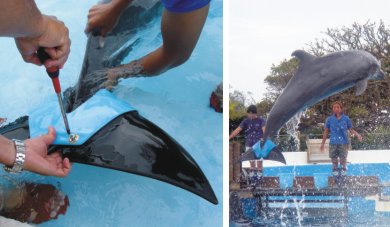
Outside the Gulf: A dolphin's tale
Printer Friendly Page
 |
PHOTO: COURTESY OF OKINAWA CHURAUMI AQUARIUM |
Fuji, a 36-year-old bottlenose dolphin (Tursiops truncates) living in Japan's Okinawa Churaumi Aquarium, has a big fish tale to tell. In the fall of 2002, she lost 75 percent of her tail flukes to an unknown disease. But the mother of three got a new lease on life when she was fitted with artificial tail flukes.
Fuji, who is 271 centimeters (8.9 feet) long and weighs 216 kilograms (476 pounds), suffered a loss of appetite, discoloration, and tissue death on the ends of her tail flukes when she fell ill in 2002. A dolphin's tail comprises two flukes, one for each half of the tail. Fuji initially was treated with antibiotics and transfusions for 60 days to combat the infection and circulation problems, but the diseased parts of the fluke had to be removed surgically in the fall of 2002. She recovered from the disease, but was missing a large part of her flukes.
Shortly thereafter the aquarium's veterinarian asked vehicle-tire maker Bridgestone Co. to help develop artificial tail flukes, a project that started in May 2003. The goal of the project was multi-fold: to test whether an artificial fin could be crafted that would work, to see if Fuji could fully recover her normal swimming behavior, and to see if Fuji could interact socially with other dolphins while wearing the artificial fin.
The first fluke cast was made of silicon in July 2003. It didn't work well because the belts to attach the flukes scratched Fuji. An acrylic sculptor was hired to make a more accurate mold of Fuji's tail in 2004, and a better attachment mechanism was made using a cowling of carbon-fiber-reinforced plastic. The result was a prosthetic tail measuring 70 centimeters (29.5 inches) wide, 25 centimeters (9.8 inches) long and weighing 2,200 grams (4.9 pounds). It worked. Fuji could swim fast and even jump into the air.
While the artificial fin is mechanically strong enough for swimming, it can't sustain the physical momentum of jumping, so efforts are ongoing to improve the materials.
Fuji did require some training to use the new tail. Like most creatures in nature, dolphins don't like foreign objects attached to their body. Fuji initially rejected the artificial tail. But patient work with her trainers helped her adjust to the artificial fin. Next the trainers threw fish into the pool so Fuji would swim and use the tail. They continued with other swimming and jumping training, and now Fuji can perform high jumps.
The aquarium is continuing to research better materials and ways to attach the artificial fin. They hope their work on it also might provide insights into the function and mechanism of the natural dolphin tail. For more information on the Churaumi Aquarium's work with Fuji see http://www.kaiyouhaku.com/en/news/05041801_01_report.html.
© 2007 The Gulf of Maine Times